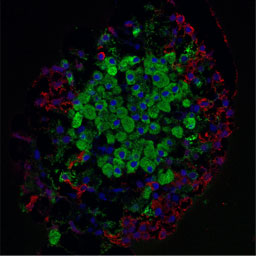Islets of Langerhans
The pancreas has two functions: to make hormones (endocrine) and to produce enzymes for digestion (exocrine).
The islets of Langerhans make the hormones insulin and glucagon. The alpha cells (stained red) make the glucagon and the beta cells (green) produce insulin. Nuclei are stained blue.
The islets make up only just over 2% of the pancreatic tissue

Alpha and beta cells in the islets of Langerhans. Source: Masur
Specialised cells
Beta cells are specialised to produce insulin. They have a well-developed rough endoplasmic reticulum , to produce the protein hormone. This is then stored in cytoplasmic vesicles before it is secreted. The process requires energy and beta cells contain many mitochondria to provide ATP.
Roll over the image to see the parts of the cell involved in insulin production.
Protein synthesis
Insulin is a protein and there are several stages in its production. The animation shows the process of protein synthesis. When insulin is being produced, it is the insulin gene in the nucleus that is transcribed into messenger RNA .
You are a unable to view this animation as you do not have the correct version of Adobe Flash Player installed. Please visit the Abobe website to install the latest version of the free Adobe Flash Player
Question 5




(C 6 H 10 O 5 ) n , that is stored in the liver and in muscles and can be converted back into glucose when needed by the body.













